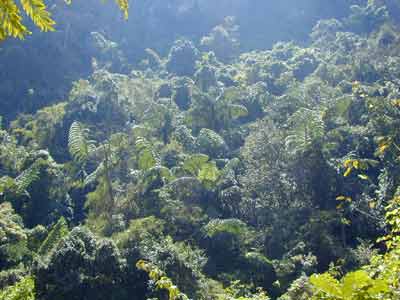 |
|
Multi-tiered Structures in the Rain Forests |
When setting foot in the rain forests, the dim light sheltered by the shades would make you think of the primitive times; and a gush of fear would occur to you immediately. These are the descriptions of the explorers in the rain forests.
Rain forests are primitive vegetation on earth and they were not affected by the glaciers in the geological history. The stable climate and environment in tropical areas, plus advantages of high temperatures in these areas, make the forests develop exuberantly and form a tall and multi-tiered forest structure. Tall and short trees are arranged in pairs and groups, and they overlap three to four layers. The trees in the first layer normally have a height of more than 30 meters, their canopies stick out and like giants over other trees; the second layer consists of tall trees with a height of 20 to 30 meters, they have quite dense canopies and are the major layer of trees in the rain forest; the trees in the third layer are as tall as 10 to 20 meters, they are mainly small arbor trees and are very dense woods; in-between 5 to 10 meters, usually there would be another layer; and under it, is a 1 to 5 meter layer consists of young trees and shrubs. The shrubs have no clear distinctions in this layer. It is no surprise that some people call it the layer of manikin trees. Under them, there is a layer consist of grasses and herbs.
Since the rain forest has many layers, there is almost no sunlight could reach the ground surface; therefore, it is quite dim under the trees, and no one could tell the time without proper equipment.
Looking at the rain forest from afar, we could see that above the dense canopies, there are many tall and light-colored trees, just like a forest above forests.
The arbor trees in the rain forest are quite peculiar in shapes. They are tall and thin, the bark is light and smooth, they have forks and branches only at places near the top, which help to form round canopies for the trees. The reason that they have light-colored barks is that, most of them are covered by mosses or aerial plants; they have smooth and thin barks, for one reason, they have no need to counterattack severe coldness and drought; the other reason is that, they don’t want mosses and aerial plants to parasitize on them; and their thin and tall body is a sort of adaptation to compete for sunlight in the dense forests.
 
|

